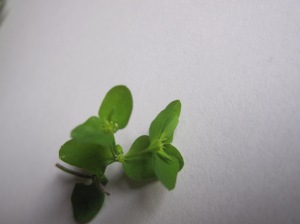Seeing as I have just bought Collins Flower Guide by Streeter and Wildflower Key by Rose, I thought I’d try them out on this plant
Now I know what this is so I’d be interested to find what the books lead me to. The Collins guide is broad ranging, it is
‘..designed as a field guide to the identification of those plants found growing wild in the British Isles and neighbouring parts of northwest Europe. It covers all flowering plants, including trees, shrubs, grasses and sedges, as well as the conifers and ferns and their allies. That is, all plants botanists classify as ‘vascular plants-those with an internal conducting system that transports water, nutrients and the products of photosynthesis around the plant.’ (Streeter 2009)page 5
however the introduction is quite short and although there is a brief introduction to keys the main part of the book starts with ‘seedless plants’ under the heading ‘Equisetaceae’, on page 10.
Now if I was totally new to plants I would probably be baffled as to what category this plant would be and I think I would have to search through the illustrations and come to the conclusion it probably isn’t a fern though it doesn’t really look like its a flower either.
Any way assuming its a plant producing seeds then its necessary to start on page 47 with an introduction to the flowering plants. This explains what a typical flower looks like with a brief introduction to the various names used to describe the parts of a plant and flower structure. The next section is interesting because it sets out how the keys that follow work.
‘..about 70 per cent of these (British plant) species belong to just 20 large families. Thus, becoming familiar with these ‘top 20′ families is an obvious first step towards identifying individual species..’ (Streeter 2009) p49
The top of the top 20 are the Poaceae or grasses and coming in at number 20 are the Chenopodiaceae or oraches.
So the key which follows only includes those in the top 20. Now I followed the key for my plant and got into difficulties almost straight away. Because the flowering heads are in an umbel like structure and are quite small I could have ended up being directed to the Apiaceae but instead chose ‘flowers not like this’. Unfortunately this ended up with the choice between flowers small and inconspicuous or not, and as they were obviously the former this led to Polygonaceae or Chenopodiaceae. And its neither of these and because there is no third option to leave the key this is a dead end.
If I then came to the conclusion it was not in the top 20 I was able to go to the next group of 5 typical families,
‘..although not so large,(as the top 20) are nevertheless very distinctive and easily recognised, and contain many common and widespread species.’ (Streeter 2009) page 49
The typical 5 are laid out on one page with small illustrations and its fairly obvious my plant belongs to the Euphorbiaceae. Then I am directed to the family key.
The family key to the Spurges Euphorbia starts with a brief introduction to the parts of the flower inflorescence called the cyathium. The key is fairly straightforward apart from with my specimen the leaves appear to be arranged in an opposite manner which would lead me to E lathyris, which it is not.
So all in all I think if I was a total beginner then I would be quite frustrated with this book. I would probably end up thumbing through the illustrations, until I got to know the main families. Next time I will try the same process with Rose (2006).



Nice approach, as a colleague of mine says, keys are fine if you know what the plant is! The serious point for a field botany teacher like me, is how to help beginners identify new plants when they have limited knowledge, so not much knowledge to triangulate against. I think I wd recommend veg key for this one!